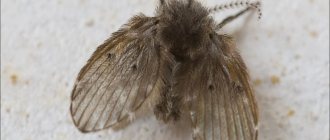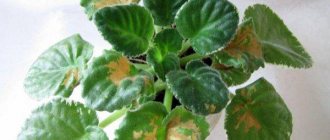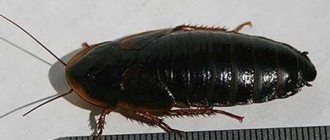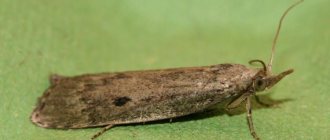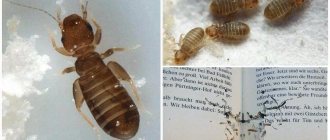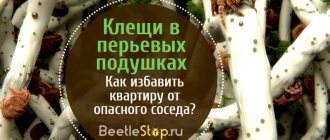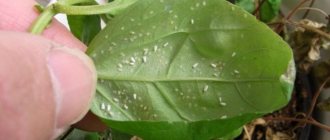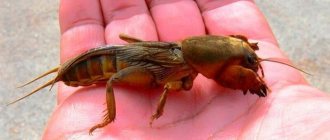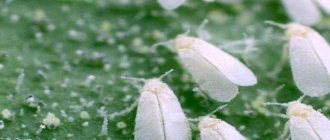The small whitefly, a photo of which can be seen below, is one of the most dangerous enemies of plants growing in closed ground conditions. Most often this pest appears in greenhouses and conservatories with insufficient ventilation. Today we will look at the two most common types of whiteflies, the features of their development and the reasons for their appearance.
Description
Small white insects that parasitize plants in the garden are familiar to every gardener. This is a whitefly. Likes to live on indoor plants and in greenhouses. This is facilitated by high humidity and frequent watering. It is rarely found in open ground, but outbreaks occur when plant growing conditions are violated. Most often found on vegetable crops: tomatoes, cabbage, strawberries, peppers. A seemingly harmless insect can turn into a real disaster for plants and their owners.
Gardeners do not immediately recognize the threat, since whiteflies are very similar to aphids. They feed on the sap of the plant, which weakens and reduces the plant’s immunity. And this, in turn, leads to the death of the seedling. Preventive measures can help, as well as timely identification of the pest.
What harm is caused?
Honeydew, which the whitefly leaves on the leaves, provokes the appearance of sooty fungus. It clogs the pores of the plant, which is why the crop gradually dies from lack of oxygen and sun. The spores spread in the wind and remain in the soil. Therefore, a small butterfly can cause crop destruction in the entire greenhouse. Infected plants are removed from the site and burned.
Whitefly is a carrier of the following diseases: leaf curl virus, golden mosaic, infectious yellowing of fruits and crop stems. When the first symptoms appear, treatment is useless; it is necessary to urgently get rid of the affected plants.
Read more about how to effectively get rid of butterfly pests in your garden and vegetable garden in the article here.
Signs of whitefly in the garden
An inexperienced gardener may confuse whiteflies with aphids, but if you look closely, you can see a significant difference. The whitefly is slightly larger in size and has distinct wings. If you shake the plant, a cloud of tiny midges will rise up.
The female hides the clutch of eggs under a leaf and looks like a cluster of white dots. The peculiarity of the whitefly is that it is prone to rapid reproduction. If this process is not stopped in time, the entire area will soon wither under its onslaught. During its life, the insect secretes a sweet consistency that covers the leaf, resulting in the formation of dark spots. Thanks to its wings, the pest quickly spreads to neighboring plants. In apartment conditions, even removing plants to the next room cannot be done, because the whitefly flies in search of new food.
The larvae develop in stages. At the end of development they turn into puparia. Puparia are light yellow cocoons from which adults subsequently hatch.
Whitefly in the photo
In the photo there is a cluster of midges on the back side of the leaf
Prevention
- Constant inspection of the leaves will help to detect the insect in time. New plants in the house are quarantined.
- Since whitefly is most often found in protected soil, thorough cleaning and disinfection of greenhouses and greenhouses after harvesting is important. Plant residues and weeds are collected and destroyed, or sent to a compost heap. The soil is dug up, its surface is not leveled until spring.
- Greenhouses are washed and disinfected, paying attention to cracks and joints. After the weather gets colder, it is better to leave the windows and doors of the structure open so that the pests that have settled in for the winter will die. At temperatures from -12°C and below, it is enough to freeze the greenhouse for a week.
- In the summer, nets are installed on doors and windows to prevent insects from entering the room.
Despite the fact that whiteflies multiply quickly, they can and should be fought against. Only systematic measures will get rid of it. Once you start fighting it, you can’t stop!
You will learn more about methods of combating whiteflies from the video.
Reasons for appearance
The most favorable conditions for insect reproduction are high humidity and warm air. Therefore, the greenhouse premises, where it is always humid and warm, are always at risk. Outbreaks occur during hot summers with frequent rainfall. Small midges are not able to withstand extreme cold. Temperatures below 10 C are already destructive for them. But the eggs are adapted by nature to preserve the species and calmly tolerate cold in the ground.
The following factors guarantee the appearance of whiteflies in a greenhouse:
- Close planting;
- Violation of ventilation and temperature conditions;
- Lack of preventive measures to combat pests;
- Lack of regular application of fertilizers that strengthen plant immunity;
- Spraying plants in a greenhouse.
Features of the pest
The pest reproduces freely and lives only in humid, warm climates. The whitefly often overwinters in greenhouses or conservatories.
The life of one individual is 30 days. During her life, a female can lay from 85 to 130 eggs. Pest eggs can be identified by their placement in the shape of a circle. Eggs may be laid in crowds or in solitary rings. Initially, the clutch is yellow, but after 9 days the eggs turn black and enlarge.
Whitefly larvae have 4 stages of development:
- a mobile and wingless individual up to 0.3 millimeters in size, it can remain in this state for 10-14 days, during which time the larva will molt and grow a little;
- the individual at the second stage looks like a small shiny scale with legs and antennae;
- the third stage is the nymph, when the individual becomes green;
- at the last, fourth stage, the individual grows to 0.75 millimeters and has transparent greenish wings.
The larvae, using glands, secrete a special sticky liquid, attach to the food leaf and tuck their legs under them. In this position they exist until they are fully formed. The formed butterflies are already very mobile; they take off when they stir the leaves of the plant and actively absorb young shoots.
Most often, whitefly affects:
- flower plants;
- cabbage and its seedlings;
- tomato seedlings;
- cucumber seedlings;
- fruit trees;
- young berry bushes.
Ways of plant infection:
- introducing the pest to wintering grounds from the street on shoes, with soil or with plants;
- purchasing already infected seedlings;
- relocation of plants from contaminated soil or greenhouse;
- independent penetration of the pest into acceptable living conditions.
Fighting methods
They fight this annoying and dangerous pest in different ways. For some, only folk remedies that do not contain chemicals and are safe for humans are acceptable, while others do not see any other way how to quickly destroy midges using insecticides and chemicals.
A special feature of treatment with poisons is the regular repetition of the procedure until the whitefly is completely destroyed. The fact is that the poison only affects larvae and adults, but not eggs. Therefore, repeated spraying is done in order to destroy the hatched larvae before they are able to reproduce.
It should be remembered that toxic substances accumulate in vegetables and eating them can be dangerous. Therefore, you should adhere to the proportions established by the manufacturer, which are described in the instructions attached to the insecticides.
Advantages and disadvantages of agrochemicals
Advantages:
- They effectively destroy not only adult insects, but also their larvae and eggs;
- Some chemicals, in addition to medicinal ones, have stimulating properties;
- Large selection of drugs on the market.
Flaws:
- Not all chemicals can be used in residential areas; some of them have an unpleasant odor and can have a bad effect on people’s well-being;
- High-quality, low-toxic drugs have a high cost;
- Some chemicals can accumulate in the soil and in the plants themselves.
Chemicals
Choose the safest drugs for treatment and follow the instructions when diluting the solution
"Admiral". It is a low-toxic drug used to kill insect pests. Available in the form of a concentrated emulsion. It is used diluted in a proportion of 0.2 l/ha. The consumption of Admiral working fluid is 1000 l/ha. Processing is carried out 1 time.
"Aktara". Treatment with this substance helps get rid of whiteflies for a period of up to 1 month. The treatment is repeated 3 times after 7 days. Vegetables can be eaten only after 60 days after the last application of Aktara. 1 sachet, containing 4 g, is diluted in 5 liters of water. This is enough for a large greenhouse area. To destroy, spray and water at the root.
"Aplaud." Can be used both in greenhouses and in open ground. Japanese insecticide allows you to get rid of insects for 1 month. Diluted 0.5 kg per 1 ha. To process 1 hectare you will need 1500 liters of water.
"Confidor". The drug is quite effective, so one treatment is enough. After an hour, the midges begin to die.
"Iskra Golden" These are tablets that easily dissolve in water. Also available in the form of ampoules, powder and sticks. A solution of 2 ml per 10 liters of water is prepared and sprayed on the plants. 1 or 2 treatments with Iskra Zolotoy are enough.
"Tanrek". A very effective and low-toxic substance that practically does not accumulate in fruits. To spray vegetables and indoor plants, you need to take 5 ml of the drug per 10 liters of water, for trees and bushes, 3 ml. Safety precautions must be observed when working with Tanrek, so be sure to wear respirators or face masks.
"Fitoverm". Dilute 4-8 ml per 1 liter of water, depending on what you plan to spray and against what pest. The treatment is carried out several times to destroy all adults and those that hatched after the treatment.
"Fufanon." Low-toxic drug, which is diluted at the rate of 10 ml per 10 liters of water. First, the solution is added to a small amount of water, and then poured into the rest. The Fufanon working solution is prepared at 3 liters per 10 sq.m.
Biological methods
This technique is very original - the pest is destroyed by another parasite. For this purpose, insect predators or biological agents are selected that will happily feed on whiteflies, but will not covet tomatoes, peppers, or cucumbers. Encrasia are insects 0.5-0.6 cm in size that destroy others. Parasitic parasites lay eggs in their prey, and the hatching larva completely kills it. One adult female is capable of destroying up to 50 aleurodids.
We also recommend reading about the larva of the cockchafer.
If no eggs are found, the rider pierces the larva, sucking out the lymphatic fluid from it. Encarzia destroys most of the most common whitefly species, significantly reducing their numbers, but rarely exterminating them completely.
Test tubes with 60-100 eggs are sold in special stores and on Internet sites, and the kit includes instructions for effective breeding. The contents are poured into several paper cups, placing them around the greenhouse every 300 cm. Encrasia sense whiteflies located at a distance of up to 20 meters. At the same time, you cannot spray the space with any chemical reagents - the enkrasia will also die.
Ladybugs and the predatory macrolophus bug protect well from aleurodids. The latter is usually housed, and yarrow, daisies, and marigolds are planted for the ladybug. Macrofulus is able to feed on plants for a long time, but only if protein food is not available. It has a greenish color and spends the winter in the ground. To combat whiteflies, 1-3 individuals are required for every 1 square meter. m. Dill planted around the perimeter of the greenhouse attracts equestrians - the worst enemies of the parasite.
Verticillin Zh is a biological preparation that contains spores of the fungus verticillium. When they hit the surface of the body of an adult insect, they germinate, not only killing this individual, but also infecting others. It should be used 2 times with an interval of 8-10 days. Ashersonia also causes epidemics in many parasites, including whiteflies. Boveria is a mushroom that is most active at a temperature of +25-28 degrees, causing enormous damage to the moth, sharply reducing its number.
Mechanical methods for fighting
Trying to protect their crops from whiteflies, gardeners install traps. They look different. Take cardboard or plastic and cover it with non-drying glue. You can prepare the adhesive mixture yourself by taking honey, castor oil, Vaseline and rosin. The smell of honey attracts parasites and they stick to the surface of the trap. Fly tape can also help.
Another effective way is to place fumigators against mosquitoes and flies on the site. The disadvantage of this method is that people and animals cannot be in the greenhouse while the fumigator is operating. Treatment is carried out after 7 days to destroy the larvae that have hatched from the egg.
Nets are also another way to protect plants from insects. Special phytoprotective nets are installed that prevent adults from getting onto the plant. There is no need to use additional chemicals and the vegetables remain environmentally friendly.
A sulfur smoke bomb is designed to “smoke” a room. The checker is used to destroy not only whiteflies, but also other parasitic insects. Smoke not only destroys pests in the garden, but also scares away newcomers. Dichlorvos, which can be sprayed on plants, also works. With the help of dichlorvos, they kill not only whiteflies, but also other pests.
Preventive actions
To prevent harmful insects from appearing on plants again, the following rules must be followed:
- ventilate and change the temperature in the room;
- wipe the leaves of the bushes once a week;
- loosen the top layer of soil;
- do not allow moisture to stagnate in flower pots;
- do not plant bushes too close to each other;
- in the fall, dig up the ground and use soil fumigation;
- the greenhouse can be frozen in winter;
- treat the soil with ash and other disinfectants;
- Cover infected plants with film to prevent midges from spreading further.
Traditional methods
Gardeners and summer residents in their small plots prefer to cope with the invasion of the parasite using traditional methods. The advantage of these methods is the absolute environmental friendliness of the fruit.
- An effective method is wiping with water. But the method is only suitable for indoor plants and a small number of seedlings. Take a sponge, soak it in water and wipe the leaves with it. The method is painstaking, but you know for sure that you have removed all the larvae.
- The composition of water and laundry soap is prepared in the proportion of 1 part soap to 6 parts water. Water the soil, but not too much, so as not to harm the roots and plant. Repeat in a week.
- Garlic tincture is prepared from 2 large cloves of garlic and 1 liter of hot water. Leave it to sit overnight and then you can spray it on.
- Yarrow tincture is prepared at the rate of 90 g of leaves per 1 liter of water. Let it brew for 2 days and spray the plants. Repeat 3 times every other week.
- Tobacco solution. Experienced gardeners recommend using Prima cigarettes. The tobacco from them is poured into a jar and filled with water. Let it brew for 5 days, strain and spray. Repeat the treatment until the midges completely disappear.
- Dandelion tincture is prepared from 40 g of leaves, 40 g of roots, which are crushed and filled with water. Let it brew for 4 days, strain and process the plants.
- Ammonia is diluted 35 ml per 1 bucket of water. Treatment with ammonia is carried out every 3 days.
- Birch tar is part of tar tincture. Dilute 5 ml per 10 liters of water.
- The vinegar solution is prepared as follows: take 5 tablespoons per 10 liters of water. vinegar essence.
